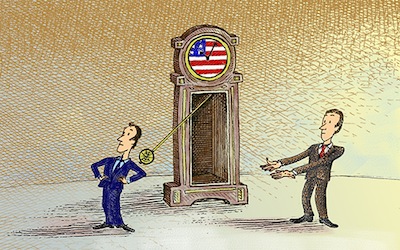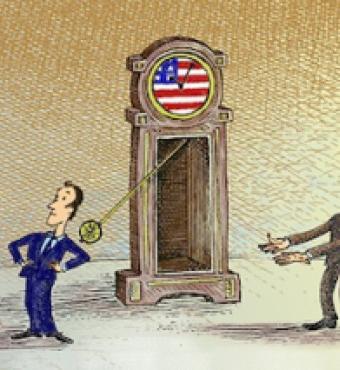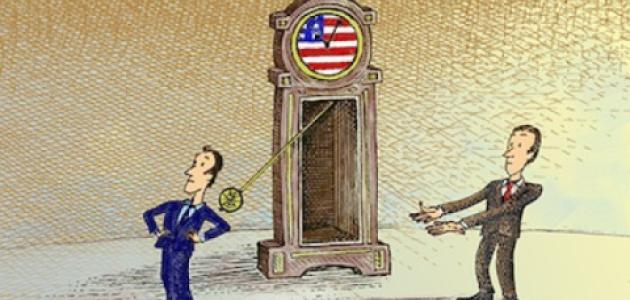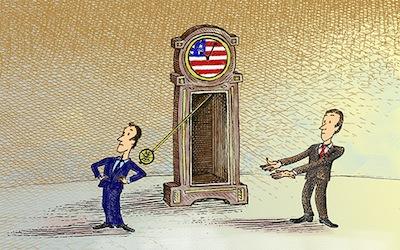Editor’s note: The essay below is an excerpt from the new book The New Deal and Modern American Conservatism: A Defining Rivalry (Hoover Press).
Following the 2012 reelection of Barack Obama, many proclaimed the death of modern American conservatism. The Titanic is sinking, said one commentator; the conservative arguments put forth in the campaign will soon be relics in a museum, wrote another. Demography is destiny, many said, and conservatism is the realm of old white men whose day is gone. This is the day of the young, of immigrants, of people of color, of women, who vote progressive, not conservative. A standard refrain was that conservatism needs to change both its methods and its message if it ever hopes to be successful again. In short, many called for an extreme makeover for modern American conservatism.
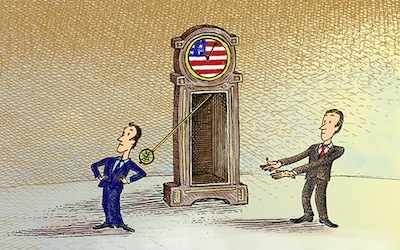
Illustration by Barbara Kelley
Others see in history a swinging pendulum, understanding that what is not in favor today may well rule the day tomorrow. In particular, election results often swing wildly from side to side, with one party racking up major victories in a presidential election, only to lose ground to the other side in the midterm elections a mere two years later. This is just what happened with Obama’s win in 2008, followed by the formation of the Tea Party and record losses for Democrats in 2010. As former British Prime Minister Harold Wilson put it, “A week in politics is a long time.”
As the co-authors of this book, long-time colleagues and friends, we confess that each of us had a different take on the consequences of the 2012 election and the future prospects for conservatism. One of us believes that a new majority of more liberal voters—younger people, ethnic minorities, wealthy elites, those receiving significant income from the government—are on the ascendancy. For him, this is a No Country for Old Men moment. He feels like the sheriff in that movie (or book) who now sees extreme irresponsibility among voters and in government. He despairs of his ability to make any real difference about it. He feels it’s time to leave California, in his view the exemplar of irresponsible governance, and retire to the most livable red state he can find.
Our other coauthor sees no reason to turn away from his Mr. Smith Goes to Washington life and career. In his case, he went to the academy in California, rather than to government in Washington, D.C., but he retains his optimism about making a difference in the lives of graduate students and high school teachers, teaching the beauty of the American Founding and its constitutional republic. He sees no need for an extreme makeover of modern American conservatism, nor to leave his beautiful California beach community for life in some cold, rugged red state. The American people are center-right, he says, and though they may get carried away in this or that election, given the right candidates and moment, they will return to their more conservative roots.
Conservatism: Of Politics, Policy, and Principle
For starters, we need to understand that conservatism operates at different levels in varied ways. In a sense, politics is only the shallow topsoil of the public arena. Polling demonstrates that voters are blown about by conventional wisdom, the latest speech or poll, or even a candidate’s hairstyle. Elections do, as they say, have consequences, and the short-term future (two to four years) may be decided there, but generally nothing long-lasting is decided in a single election. In addition, we must understand that a political philosophy, such as conservatism, doesn’t really stand for election. Individual candidates run for office, and political parties do battle in elections. But ideas and philosophies are, or at least should be, much deeper than that. Republicans are not consistently -conservative—in fact, as noted in chapter 3, large growth in government has often occurred under Republican presidents. And Democrats are not always liberal. So it would seem naïve, at best, to assume that the long-term fate of a political philosophy such as modern American conservatism would be settled on a single election day in November 2012.
As a consequence, conservatism is not likely to be resurrected, or even significantly strengthened, by tinkering at the political level. When people say Mitt Romney was not a great candidate, or did not run a strong campaign, that may have little to do with conservatism, per se. For one thing, there is a view strongly held by many that Romney himself was not truly a conservative candidate. Both his record as governor of Massachusetts and his evolving stands on a number of issues made him seem more like a pragmatic businessman than a political conservative.
Further, the fact that Obama won the election does not mean that this was a highly ideological campaign in which political philosophies were the decisive factor. Some argue that the 2012 election was very close until Romney’s private remarks to donors about 47 percent of Americans being dependent became public and Obama looked presidential in his response to Hurricane Sandy. The point is that campaigns and elections should not be ignored, but they more often turn on the state of the economy, or incumbency, or the attractiveness of the candidate, or the effectiveness of the campaign, and are not necessarily good barometers of how a particular political ideology sits with the American public. Still, as candidates and parties try to solve their political problems, it is important to see whether conservative principles are helped or hurt in the process.
At a deeper level is the realm of policy, where particular approaches to issues and problems are developed and where ideologies such as conservatism are very much in play. Unfortunately, the political landscape at the moment seems to be choking out thoughtful policy development, not only from a conservative point of view but more broadly. The Democrats don’t really have a coherent set of policies now, other than to raise taxes on the rich and try to “stimulate” (a politically correct word for “spend”) our way toward economic recovery. But they do appear to be more in touch with voters’ concerns, even if they do not have policy solutions for them.
The Republicans essentially do not want to raise taxes on anyone at any time, and say they want to tame government spending, though a lot of the increased spending happened on their watch in the first place. Romney started his fall presidential campaign with a fifty-nine-point plan for the economy, which sounds more like what a consultant would deliver to a paying client than what a candidate should offer as a coherent set of policies. Finally he got it down to five points. Republican vice presidential candidate Paul Ryan was the closest candidate we’ve had to a policy wonk since Bill Clinton, having published a detailed plan on the budget and economy. But conservatives could very much use a candidate, or a set of leaders, who could advance clear, coherent, conservative approaches to the policy issues of the day, including immigration, gun control, the budget, and so forth.
At the deepest level are the principles that animate a particular philosophy, such as conservatism. Here is where conservatives have a lot of work to do. One problem is that conservatism is, in many ways, more of a reactionary philosophy than a proactive one. As William F. Buckley famously said, “A conservative is someone who stands athwart history yelling, Stop.” Since its primary purpose is to conserve liberty, and also the traditions and institutions that help protect individual liberty, the message of conservatism is often in reaction against government efforts that would harm liberty. So its principles come off as reactionary and negative—no taxes, turn back the clock on abortion, and so forth. Another challenge is that some conservatives, such as social conservatives, have a different set of principles than classic or fiscal conservatives. So finding a common set of principles for conservatives, one that seems to suit the times, is a challenge that has to be confronted with regularity. In order to work that out in these times, it seems important for conservatives to address a series of difficult questions.
Does Liberty Still Resonate?
For Edmund Burke, the father of modern conservatism, the essence of conservatism was individual liberty. The Founders, in the words of the Declaration of Independence, sought “life, liberty, and the pursuit of happiness.” Herbert Hoover, who was resisting the vast government expansion and intrusion of Roosevelt’s New Deal, entitled his volume of writings The Challenge to Liberty. So for 150 years, from the Founding to the New Deal, liberty resonated in America. Why do immigrants still want to come to the United States today? For the opportunities that liberty provides.
But does individual liberty still resonate today as a principle worth fighting and voting for? Do younger people, who have grown up knowing only big government, appreciate a philosophy that sees government as a potential threat to liberty? Has individual liberty become merely an abstraction that no longer speaks powerfully to the American people? There are three basic liberties we have historically held dear: economic, religious, and political. But do people really see the threats to them today?
It is no longer enough to merely repeat the conservative principles. It has become necessary to animate, illustrate, and remake the case. When a decorator said I could only use certain kinds of handles in my shower, by law, that helped illustrate that I live in a much more highly regulated state than I would like. In New York City, Mayor Bloomberg wants to regulate the size of soft drinks. When your monthly paycheck dropped dramatically in January of 2013, that was a vivid reminder that taxes were going up. When you work well into April, and in some states even into early May, simply to pay your taxes, that’s a powerful reminder of how much government you have, and how much you are paying for it. This is a threat to economic freedom, to the fruits of one’s labor, but that message is not getting through.
Young people, in particular, do not readily see the twin problems of too much government and too little individual freedom. A Pew Research Center survey reported in November 2012 that voters under age thirty are the only age group in which a majority said government should do more to fix problems. Of course, young voters will soon enough be older voters, and will experience higher taxes and more restrictions. But this is a reminder that the case for limited government and for individual freedom must be remade in every generation. These young voters need to see the attraction of churches and nonprofits and other intermediary civic associations that conservatives love more dearly than just deferring problems to the government. So even at the core of conservative principles—individual freedom—there is much work to be done to sharpen the focus and communicate the message in clearer and more compelling terms. Individual liberty, to many, has become merely an abstraction.
Is it Time to Give Up on Tradition, Virtue, and Social Values?
Younger voters are raising the question whether conservatism needs to give up on its effort to, as they see it, tell people how to live. Of course the libertarian branch of conservatism has long embraced the notion that individual freedom should include the freedom to live as you want, without interference from government. Still other conservatives might not characterize themselves as libertarian, but would say they are fiscal conservatives but social moderates (or even liberals), again willing to abide a variety of individual decisions about lifestyle. Social and Christian conservatives have become an active and important voting bloc since the 1970s, attempting to define conservatism to include positions on abortion, gay marriage, stem cell research, and so forth. These positions, it is argued, especially turn off younger voters, who identify more with liberals (or, if they knew more about them, libertarians) on these social issues. Herbert Hoover’s great-granddaughter, Margaret Hoover, published a book in 2011 making this case: American Individualism: How a New Generation of Conservatives Can Save the Republican Party.
But one of the dilemmas of conservatism is that it has long embraced both individual freedom and the traditions and values that uphold it. Edmund Burke embraced a “manly, moral, regulated liberty,” understanding that tradition actually strengthened freedom. The Founders understood that, as Benjamin Franklin put it, “only a virtuous people are capable of freedom.” So long before the emergence of social conservatives or the Christian right, there was an understanding that liberty, or doing as you wish, required the restraining influences of virtue and tradition, or doing as you ought or has long been done. Conservatives, then, need to be cautious about throwing out the baby of virtue and tradition with the bathwater of social and religious conservatism.
Peter Berkowitz, in his recent book Constitutional Conservatism, attempts to bring into one tent the two primary branches of conservatism: libertarianism and social conservatism. A key part of his approach is that he would require social conservatives to accept that the sexual revolution is here to stay and to quit fighting that battle on the political stage. But if your religious understanding is that God forbids abortion or contraception, it seems like a bridge too far to say you must give up a fight against having government, or your tax money, support and advance those practices.
It does seem important, however, for conservatives to find a way not to insist that government support certain specific religious or social beliefs, without giving up entirely on the broader virtues and traditions that support a free society. Perhaps the focus could be more on some of the public virtues such as honesty and moderation that truly allow a free society to function. Or, more practically, perhaps social conservatives need to be challenged to temper their views with traditional conservative notions of federalism, which calls on government to act only when individual action is insufficient, then insisting that the lower levels of government act when federal action is not truly needed.
So, then, social conservatives might be discouraged from pressing their views at the federal level in favor of the Defense of Marriage Act, for example, recognizing that marriage should really be a matter of state policy. Social conservatives would then have to accept a variety of social policies in the states. Similarly, conservatives, who preach against judicial activism, should accept the self-discipline not to turn every question into a federal lawsuit. This is a kind of moderation that might allow conservatives to be faithful to their core principles, yet reach a broader public. As difficult as these steps may be, it seems far preferable for conservatives to attempt to work through the difficult dilemmas of values in a free society rather than throw tradition and virtue out of their politics altogether.
Is the Constitution a Gathering Place or a Stumbling Block?
As noted in chapter 2, there is a view, especially in the academy, that the Constitution is an old, anachronistic document that is not relevant to the issues of our day. Some would go further and argue that, having been drafted by landowning men who would not abolish slavery, the Constitution was flawed from the beginning. Those are more extreme views, but even people in the middle wonder about seemingly abstract notions of federalism such as the Electoral College or limitations imposed on Congress by the tenth and fourteenth amendments. If we have a major national issue such as health care, why can’t the federal government step in and act? Why would it be constrained by a 225-year-old document?
But the Constitution must be a central part of the conservative case going forward. It is primarily through the Constitution that we find balances of power, checks and balances, and limits on the power of government. These are the very tools that would enable conservatives to continue to wage the battle that is central for them: the campaign for limited government. In fact, it would behoove conservatives to be ever more active in civic education efforts, since constitutional principles have become another of those abstractions that many citizens fail to appreciate. Tellingly, when we coauthored a newspaper quiz for Constitution Day a few years ago, a friend called to say he had failed the test, but his girlfriend, an immigrant, had passed with flying colors. Why? Because she had taken the required dose of civic education needed for citizenship. The problem with the Constitution is not what it says; it’s that people don’t know what it says and fail to appreciate its meaning and value.
Another way in which the Constitution can be a way forward for conservatives is its value in uniting the disparate elements of the movement. There are fiscal conservatives, social conservatives, Christian conservatives, and libertarians, just to name a few branches of the conservative tree. But one trunk that could sustain all the branches would be strong allegiance to the Constitution. The First Amendment’s free exercise of religion empowers Christian conservatives. The Tenth Amendment’s reservation of power to states and the individual is the anthem of conservatives who want limited government. The taxing power, the interstate commerce test, balances of power, checks and balances, they’re all there in the Constitution. Defending, explaining, and teaching the Constitution should be right near the top of the conservative agenda going forward.
Is There Reason for Optimism about the Future of Conservatism?
We know there are reasons for despair about the future of conservatism in America. After Ronald Reagan, by acclamation the last great conservative president, passed the office to his vice president, George H. W. Bush, the more conservative candidate for president has lost four of six elections. Chief Justice Roberts’s surprising decision affirming the constitutionality of health care reform, followed by Romney’s loss in 2012, pretty well cements the addition of health care to the permanent and expensive roster of government entitlements, the most historic such development in nearly fifty years. The several branches of conservatism are difficult to hold together, and its appeal to a younger and more ethnically diverse electorate seems less than compelling.
Still, there are reasons for optimism about the future of American conservatism. In a symposium in its January 2013 edition, Commentary shared the perspectives of fifty-three leading American thinkers and writers on “What is the Future of Conservatism in the Wake of the 2012 Election?” Some thoughtful responses affirm both a reason for optimism as well as some concrete steps that might be taken toward a hopeful future for conservatism. For example, Larry Arnn, president of Hillsdale College, states that conservatism “must repudiate absolutely this system of limitless government. . . . It must proclaim without ceasing the good of freedom and the danger to it.” We agree. And that was certainly Hoover’s view in the 1930s, one that captures the enduring core of modern American conservatism.
Michael Barone, resident fellow at the American Enterprise Institute, points out that the economic difficulties may draw a line in the liberal sand that will allow conservatives to gain some traction. As he says, “The dire fiscal plight of the federal government and the unsustainable trajectory of entitlement programs give them more leverage than they would have from their House majority alone.” AEI President Arthur C. Brooks lays out a challenge: conservatives must patiently and persistently change the conventional wisdom that holds that the free enterprise system is fundamentally unfair and that the entitlement state is morally acceptable and economically sustainable. This is an important reminder that conservatives have a lot of work to do, not on the surface level of politics so much as in the deeper trenches of values.
One set of views holds that the present road of progressivism will ultimately reach a dead end, offering conservatives an opportunity to step forward with an alternative course. As James Piereson, head of the William E. Simon Foundation, says, conservatives are well prepared to “step into the breach when liberals run the system aground,” as Reagan and former British Prime Minister Margaret Thatcher did. “The day is fast approaching,” Piereson continues, when conservatives will be called upon to play that role again. “The postwar order is unraveling, America’s economic engine has stalled, but the baby boomers are retiring, and the world still needs US leadership.” Political scientist James Ceaser, at the University of Virginia, told a conference in December 2012 that there will be a day of reckoning—a result of taxes, a slow economy, fear of losing benefits, weakness or error in foreign policy—when conservatives will again need to step forward.
It appears that President Obama intends to press a more strident progressive agenda in his second term than he did in his first, which may open new opportunities for conservatives. As President George W. Bush discovered when he used his reelection to seek major changes to Social Security, it is easy to overplay the mandate of a close election. And President Obama may well be on track to do just that. Obama’s second inaugural address called for a kind of collectivism that he believes would make America a fairer and more democratic nation. He wants more taxes on the wealthy and an array of new programs that he said in his 2013 State of the Union message would not add a single dime to the federal budget, a claim that strains credulity. By this theory, progressivism will again self--destruct, and conservatives need only stay the course and await their moment.
In sum, we agree with Jennifer Rubin, who writes the “Right Turn” blog for the Washington Post, when she said, “If modern conservatism, in its essence, is the defense of freedom and security by limited government and the cultivation of a virtuous populace through intermediary institutions (family, church and synagogue, and civic organizations), then its currency is strong.”
Still Relevant After All These Years
Conservatives would do well to ask themselves several historical questions. First, why, after 225 years, are the Founders still relevant? The answer would seem to be the power of first principles, the Founders’ ideals of individual liberty and limited government, which should still be important to conservatives. But intriguingly, why, after eighty years, should the New Deal still be relevant? Is it because, in a time of crisis and fear, Franklin Roosevelt won several elections and took advantage of the opportunity to reinvent American domestic and constitutional policy? And that we still live under that same basic framework of his high-tax, high-regulation, high-welfare, high-entitlement state today?
What then is the relevance of conservatism today? Is it just to be ready when progressivism falters, as it did when Jimmy Carter gave way to Ronald Reagan? Is it merely to set up a loyal opposition, to limit the excesses of progressivism, to “stand athwart history yelling, Stop,” as William F. Buckley suggested? In this sense, it is possible to see the appeal of progressivism, which has a more optimistic view of the nature of man and the possibility of steady, scientific progress.
Conservatives, by contrast, understand that human beings need restraint, which often comes off as a more pessimistic face. Progressives are good at finding stories of individual suffering and turning those into campaigns for changes to public policy. If someone isn’t doing well financially, it must be the fault of the system. Failure to achieve equality must be a market failure and so, progressives say, clearly we need more government regulation. We must do something! Conservatives would trust individuals and churches and civic associations to do something effective about these cases of individual suffering rather than developing government programs to address them.
We identify with the conservative Willmoore Kendall, a practical Oklahoman who believed Americans carried their -tradition, their moral sense, indeed their conservatism, “in their hips.” Their vote may be captured by some charismatic progressive—a Roosevelt, an Obama—but at the end of the day, we are still a center-right people, in our hips. We may vote to tax the wealthy and give the rest of us an easier ride, but we also want forces to counteract that impulse, lest we get carried away and ruin the economy or, worse, the republic. We may want freedom, but we also want restraint, lest we run the ship of state aground. This, we argue, is the role of modern American conservatism. It speaks from our hips. It is the restraint, the brakes, the counterbalance when the intellectuals and politicians and progressives get carried away. Conservatism allows what the Founders called the cool and deliberate sense of the community to win out over time, rather than seeing the country carried away by the politics or factions of the moment.
In that sense, modern American conservatism is just what we’ve been saying needs to be preserved. It is the Constitution with its checks and balances, its balances of power, its restraints on government. It is our traditions and values and virtues that make it possible to live responsibly within a free republic. It is our instinct to limit government lest it run over us. It is the set of boundaries in which the game can be played.
And so conservatism is a voice, an influence, a set of ideas that must be healthy and vital in order for the republic to stay on track. Modern American conservatism started with Herbert Hoover, a prophetic voice in the progressive wilderness of the New Deal, calling Americans back from excessive government, the regulated life, the temptation toward the totalitarianisms of Europe offered by the New Deal. And it became a movement in the 1950s, led by Russell Kirk, Friedrich von Hayek, William F. Buckley, Milton Friedman, and others. It produced a presidential candidate, Barry Goldwater, in the midst of the progressive excesses of Lyndon Johnson’s Great Society. It delivered its first president, Ronald Reagan, when Jimmy Carter could not command the ship of state effectively. It produced a “Contract with America” that limited the span of Bill Clinton’s reach, even prompting him to say that the era of big government was over. Its voice was heard clearly on the Supreme Court through Chief Justice William Rehnquist, Antonin Scalia, and others. When Barack Obama won his first term, it spawned a Tea Party and won the midterm elections.
And now it prepares itself for the next chapter. If it is wise, it allows others to worry about electoral strategies and politics and it digs deeper into policy and principle. Perhaps, after eight years of progressive policies, the pendulum swings back toward conservatism. Or maybe the progressives overstep their mandate and things turn more quickly to conservatives. It could be that with several conservatives serving as governors, our states will once again become powerful laboratories and produce the policies that will lead to a resurgence of conservatism.
Perhaps it will require a decade for conservatives to work at the deepest levels on conventional wisdom and turn things back toward limited government, balanced budgets, moral and traditional restraint, and, most of all, individual liberty. Ultimately it will require a candidate who embodies the principles of conservatism and can communicate them in compelling ways to the American electorate. This is both the legacy and the future of modern American conservatism.







